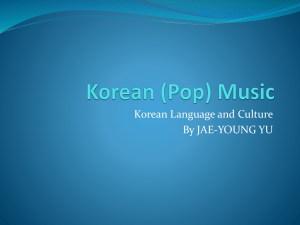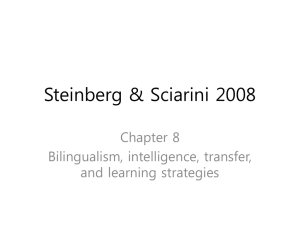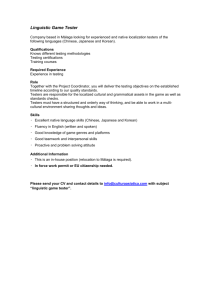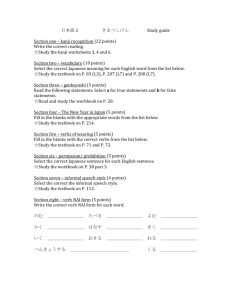On Origins of Korean supnita and Japanese desu/masu
advertisement
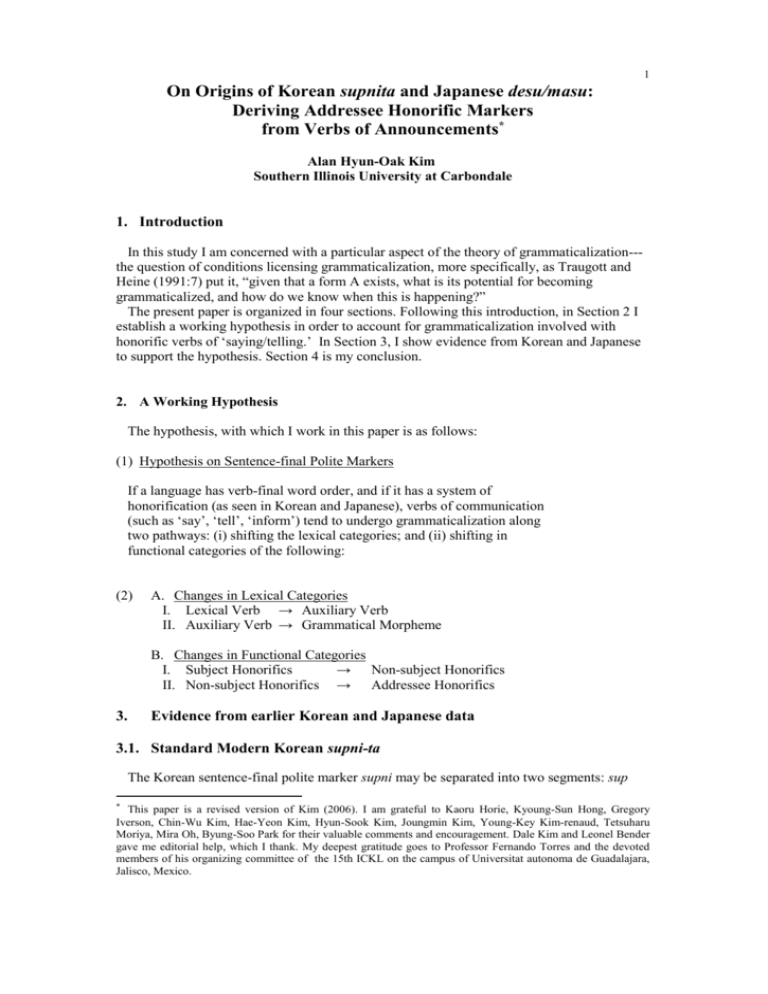
1
On Origins of Korean supnita and Japanese desu/masu:
Deriving Addressee Honorific Markers
from Verbs of Announcements*
Alan Hyun-Oak Kim
Southern Illinois University at Carbondale
1. Introduction
In this study I am concerned with a particular aspect of the theory of grammaticalization--the question of conditions licensing grammaticalization, more specifically, as Traugott and
Heine (1991:7) put it, “given that a form A exists, what is its potential for becoming
grammaticalized, and how do we know when this is happening?”
The present paper is organized in four sections. Following this introduction, in Section 2 I
establish a working hypothesis in order to account for grammaticalization involved with
honorific verbs of ‘saying/telling.’ In Section 3, I show evidence from Korean and Japanese
to support the hypothesis. Section 4 is my conclusion.
2. A Working Hypothesis
The hypothesis, with which I work in this paper is as follows:
(1) Hypothesis on Sentence-final Polite Markers
If a language has verb-final word order, and if it has a system of
honorification (as seen in Korean and Japanese), verbs of communication
(such as ‘say’, ‘tell’, ‘inform’) tend to undergo grammaticalization along
two pathways: (i) shifting the lexical categories; and (ii) shifting in
functional categories of the following:
(2)
A. Changes in Lexical Categories
I. Lexical Verb → Auxiliary Verb
II. Auxiliary Verb → Grammatical Morpheme
B. Changes in Functional Categories
I. Subject Honorifics
→ Non-subject Honorifics
II. Non-subject Honorifics → Addressee Honorifics
3.
Evidence from earlier Korean and Japanese data
3.1. Standard Modern Korean supni-ta
The Korean sentence-final polite marker supni may be separated into two segments: sup
*
This paper is a revised version of Kim (2006). I am grateful to Kaoru Horie, Kyoung-Sun Hong, Gregory
Iverson, Chin-Wu Kim, Hae-Yeon Kim, Hyun-Sook Kim, Joungmin Kim, Young-Key Kim-renaud, Tetsuharu
Moriya, Mira Oh, Byung-Soo Park for their valuable comments and encouragement. Dale Kim and Leonel Bender
gave me editorial help, which I thank. My deepest gratitude goes to Professor Fernando Torres and the devoted
members of his organizing committee of the 15th ICKL on the campus of Universitat autonoma de Guadalajara,
Jalisco, Mexico.
2
and ni. We owe the two-part analysis of supni previous studies by two authors, Ogura (1929
and elsewhere) and H. K. Kim (1947 and elsewhere). In his 1929 and 1938 diachronic studies
of Hyangga, Ogura isolated two series of morphemes sp (5a) and i (5b) as separate
entities, and he suggested that the former may be derived from Old Korean slp, and also that
both sp (5a) and i (5b) have developed to the present-day (su)p and ni, respectively.
In this conjunction, Ko’s (1944:125) following observation is intriguing. Namely, the form
p-ni is found only from the late 19th C. The earlier appearance of sup-ni may be explained
naturally from the assumption that sp is ancestral to the modern sup-ni form, which serves as
the base of the p-ni form.
H. K. Kim notes that the verb sp became the marker of Referent Honorifi-cation,
particularly Non-subject Honorification, and further it had lost its original function by
resulting in a simple grammatical morpheme of Addressee Honorification incorporated into
the second component i. The grammaticali-zation through the categorical conversion is said
to take place during the late 15C and the early 16C. More detailed derivational paths of the
two morphemes can be seen on Heo’s (1963) chart below.
Shilla/Koryo
Subject
Honorific
Referent
(DO/IO)
Honorific
Honorific
Addressee
Late 15C/Early 16C
賜 → 教(是)
白教(時)
白
音
→
→
→
→
→
→
→
sp
i →
賜立→ 受勢→
少時
si
zsi
17C
si
psi
sp1
→
sp2
→
{i, i} → {i, i} →
syosyə
→
syosyə
18C & thereafter
→
→
si
apsi/opsi
(yeccu-ta/pweop-ta)
op/sap/jap
(hanaita/haopnai-ta)
(e.g. kali-ta/ kapni-ta)
→
sose
Table 2: Historical changes in sp and ŋi (Heo 1963)
Heo’s chart above is particularly significant on four points. (i) Three modes of honorification
are identified; (ii) The split of sp1 and sp2 around the 17th Century (The subscript is
devised by AHK.); and (iii) Making distinction between two subtypes in Addressee
Honorification; (iv) Isolating the honorific imperative form sose. Heo’s identification of sp1
and sp2 is critical from the grammaticalization point of view. The process of verb to
morpheme is neatly shown in his analysis. The form sp1 maintains the status of a fullfledged verb ‘to tell something to Superior’ up to Modern Korean with the original meaning
intact. The second sp2 , on the other hand, reduced its form to that of an auxiliary verb from
the 18th century and eventually it turned into the functional polite marker (su)p-ni-ta, the
sentence-final function word for Addressee Honorifics. The last item sose, which seems to
correspond to Ogura’s so-series (5c), appears exclusively in imperative (‘the speaker’s
petition for the superior’s merciful favor’). Thus, (su)p-ni may be said to have undergone
stages of I and II of the A category and I and II of the B category as well. 1, 2
3. Evidence from earlier Korean and Japanese data
3.1. Middle Korean slo-ta and Classical Japanese soro
3
Evidence suggests that the present day addressee honorific markers such as Korean
(su)pni-ta and Japanese desu/masu, seem to be derived from full-fledged verbs of
communication.
In Middle Korean texts, there are many occurrences of the non-subject honorific auxiliary
sp-ta or its variant slo-ta, ‘convey messages to Superior,’ which is first observed by Ogura
(1929). The auxiliary verb sp-ta and its variants are exemplified below, which I borrow
from Lee & Im (1983:228).
(3) Sinha-i nimgm-l top-sʌpa [sp-ta]
sibjects-NOM King-ACC help-HONO-and
‘Ministers assist the king, and ….’ (Seogbosang Jeol 8)
(4) Taejung-tul-i…puthyə-ll
po-zapae s təni [zp-ta]
people-PL-NOM Buddha-ACC looked-at-HONO PAST-then
‘When People looked at Gautama….’ (Seokbosang Jeol 13)
(5) Ayu-i…….sejon-s anpu-ll mut-jap-ko [jp-ta]
Ayu-NOM Shakamuni’s safety-ACC ask-HONO-and
‘When Ayu asked about Shakamuni’s safety……’ (Seok Jeol 6)
Unlike sp-ta, the lexical item slo-ta in (6) below is used as a full-fledged di-transitive verb
‘reports/tells messages to a third party who is superior to the speaker.’ (Quoted from Nam
1997: 936)
(6) ms il-l
slolila
what thing-ACC say-would
‘What should I say?’ (Songgang Gwangdong Byeolgok)
(7) k paski sto
syəl-un il-ll jsehi slolila
that other than again sad thing-ACC in detail tell
‘Tell (your Senior) in detail about all your sad stories.’ (Boguk. Haein. 31)
(8) ilhum-l sloti syəngin-ila
name-ACC say holy person-be
‘He is called a sage.’ (Weongak sang 2:2)
(9) msik-l
kchoa tliko
slo ti
dishes-ACC prepare submit-and said that…..
‘(She) prepared dishes to put them in front of him and said …’ (Oryun1:54)
In (9), the noun msik ‘food/dishes’ is Direct Object of the lexical verb slo-ta and Superior
as Indirect Object thereof. Recall that Old Korean slp (白 in the Idu transcription) was
originally a di-transitive verb with the meaning of yeccwu-ta ‘tell an honoree about
something’ or pweop-ta ‘have an audience of Superior.’ Modern Korean salwe-ta/salœ-ta
goes back to slp, according to Pyojungugeo Daesajeon ‘Standard Unabbreviated Dictionary’
(1999:3110). Heo (1963) claims that slp underwent two separate paths: (i) it changed to
slo-ta and further became salœ-ta with its original meaning intact; and (ii) it turned into an
auxiliary verb of Non-Subject Honorification and eventually became a grammatical marker of
Addressee Honorification in Korean.
As for Classical Japanese polite marker sourou, its usage in letter-writing was extremely
4
popular in Medieval Japan and throughout the Japanese feudal periods up until the turn of
the 19th century.
The Japanese politeness auxiliary verb sourou is suffixed to the infinitive (the literary
negative infinitive) for addressee-oriented honorification. It had established itself as a bound
morpheme (or auxiliary) far back in pre-Middle Japanese. Particularly, it became omnipresent
in pre-modern Classical Japanese spoken among samurai intellectuals of the Edo period 1.
Thus, Old Korean referent (non-subject) honorific verb slp-ta underwent
grammaticalization (verb → grammatical bound-morpheme) to become an Addresseeoriented polite marker. Classical Japanese sourou may be contrasted as shown in Table 1
below.
CJ
sourou
MK
slo-
Phonological
shape
sibilant/liquid
and low vowels
sibilant/liquid
and low vowels
Meaning
‘say’ ‘tell’
say’ ‘tell’
Indirect object
referred to
Superior to the
speaker
Superior to the
speaker
Grammaticalization
Processes
Lexical Verb → Object Hon →
Addressee Hon
Lexical Verb → Object Hon →
Addressee Hon
Table 1: Correspondences between CJ sourou and MK slo-ta
It is particularly remarkable that both Old Japanese sourou and earlier Korean slounderwent the three-stage grammaticalization paths in a parallel way, namely, Phase I (Fullfledged lexical verb) → Phase II (Non-subject (object) honorific auxiliary verb) → Phase III
(Addressee honorific morphemic marker).
On the basis of etymological resemblance and diachronic parallelism in
grammaticalization, one might suggest that Classical Japanese sourou and Middle Korean
slo-ta (for that matter, Old Korean slp, à la Ogura 1938) shared a genetic ancestor at an
earlier time.2
3.2
Classical Japanese mousu
One will find the Japanese verb mousu is highly homophonous, and there are three distinct
usages. Let us call them mousu1, mousu2, and mousu3, and their functions are:
(10) a. mousu1 (Lexical verb ‘to serve Superior,’ ‘to wait on Superior,’)
b. mousu2 (Lexical verb ‘to tell Superior,’ ‘to say to Superior,’ )
c. mousu3 (Auxiliary for Referent (IO) Honorifics with loss of the
original meaning)
Mousu1 is a full-fledged transitive verb having the meaning ‘to serve Superior,’ to attend
Superior,’ ‘to accompany Superior’, etc. as seen below.
(11) Mifune sasu situo-no tomo-ha kawa-no se
mouse. (Man 4081)
boat draw servants-TOP river-shallow water inform
‘Boatman, explain to your master that the river is shallow.’
(by Nakanishi 1981)
Mousu2 is equivalent to ‘tell’ or ‘say’ in English. The verb expresses Speaker’s deference
It is said to be related originally to the noun samurai. Satō (1962) shows the etymological development of
sourou as in (13) below.
(13) samorapu > saburapu > saurapu > sourou (Satō 1962: 2.138-9 from Martin 1975:1039)
2 Cf. Satō Kiyoshi (1962) for a different analysis.
1
5
toward Superior as Indirect Object (not Superior as Addressee) in a sentence.
(12) Sin dainagon-mo hira-ni mausare keri
new chief counselor-too sincerely say-PAST
‘The newly appointed Chief Councilor of State also said so.’
[Heike 1] (Kōjien 1981:2183)
The third kind (mousu3) is attached to the main verb expressing Speaker’s deference toward a
referent Superior, i.e. Indirect Object, and its function is merely that of an auxiliary verb with
no specific meaning of ‘saying,’ as shown in the following examples.
(13) Sensei-no otaku-wo
o-tazune-mousi-ta.
teacher-GEN house-ACC
visit- HON-PAST
‘I visited my teacher’s home.’
The item mousu3 does not seem to have the meaning of announcement, and we may
conjecture it may have derived from either mousu1 or mousu2. The former may have changed
to an auxiliary by keeping its semantics of ‘servitude’ intact. The second choice, i.e. mousu2
may have lost the original functions of full verb status as well as the semantics of saying
altogether. Of the two, mousu1 would cost less for the subsequent grammaticalization in
comparison to mousu2 in terms of the degree of the relevance, which is roughly similar to
Yoshida’s (1971) suggestion that the modern masu might have its root in mawosu ‘tells,
humbly does.’ Note that the analysis proposed here has a two-stage process, namely, first,
from verb to auxiliary, then from the auxiliary to bound morpheme of the polite marker masu.
Now let us turn to Korean data corresponding to Japanese maosu. The Korean lexical verb
moesi-ta or its variants moysi-ta/mōsi-ta have one meaning ‘to serve Superior,’ but in two
different functions, that is, the former as a lexical verb and the latter as an auxiliary verb, as
exemplified for the first kind in (14) and for the second in (15) below.
(14) K. Ce pang-ey cosang
sincwu/wiphay-ka mōsye-ce
iss-ta
J. Ano heya-ni senzo-(no) ihai-ga
matur-are-te aru
that room-in ancestor
mortuary tablet-NOM enshrine-PAS-be
‘They enshrined their ancestral tablets in that room.’
(15) K. Cal annay-hay mōsi-e-la
J. Yoku go-annai mosi-age-yo
well guide serve-IMP
‘Give a nice guide (to the guest).’
Functions of these three different mousu are summarized below.
(16)
Japanese
a. mousu1 ~
b. mousu2 ~
c. mousu3 ~
Korean
moesi-ta1
moesi-ta3
Functional Category
(full verb of servitude to Superior)
(full verb of reporting to Superior)
(auxiliary verb of servitude to Superior)
Two things are noteworthy: first, the resemblance between the Korean and Japanese data is
quite remarkable in terms of their phonological shape and semantic/ pragmatic functions (‘to
serve Superior’). Second, the Korean counterpart of mousu2 is missing in (16b). Korean
speakers use a verb salwe-ta or Older slo-ta in the place of mousu2. One can assume that
Japanese mousu2 might have an origin entirely different from mousu1. Namely, mousu2 may
be related to Middle Korean malsm or malsam, which corresponds to Japanese o-kotoba
‘word, speech, language or Superior’s message.’ The following seems to support this thought:
6
(i) the phonological resemblance between Old Japanese marasuru and the Middle Korean
noun malsam; (ii) a parallelism in a sentence-final idiomatic expression: Korean ~la-nun
malssum-i-yeyo and Japanese ~ to iuu koto desu-yo ‘that’s the way it was’: (iii) a parallelism
between the sentence-filler na-mosi (‘you know’) in Japanese dialects (Prefectures of
Tokushima, Gifu, Gunma etc.) and colloquial Korean la-n-malssum-i-ya. (Cf. a detailed
discussion in Kim 2006.)
3.3 Middle Korean op-sose and Old Japanese asobase
Pervasive occurrences of the phrase op-sose are found in Middle Korean material, Buddhist
narratives in particular. The honorific imperative form op-sose is frequently found in prayers
even today. Now let us consider the following:
(17) Melli ttena-ka-nun
ku-eykey unchong-ul payphwule cwu-si-op-sose.
far away leave-ATTR him mercy-ACC provide give-HON-please do
‘Give thy mercy to the person who is going far away.’
In (17), the speaker asks the Lord to give His mercy to a third person (not to the speaker
himself) in the sentence. The imperative mood expresses the speaker’s soliciting mercy of the
addressee (Lord).
(18) Yehowa-ye cwu-uy pun-ulo
na-lul kyenchayk-haci ma- op-si- mye
lord
Your anger-with me
rebuke
do-not please-and
cwu-uy cinno-lo
na-lul cingkye-ha-ci ma- op-sose
Your
hot displeasure-with me
chasten-do-not
please
‘Lord, do not rebuke me in Your anger, nor chasten me in Your hot
displeasure.’ [The Old & New Testament (Psalms 6:7) The King James
Version and Korean Revised Hangul Version), Daehan Seongseo
Gonghoe. 1985:806]
The above is a quotation from the Old Testament. This type of honorification survives only in
literary writing and in dialects of a much simpler form.
At this point, I would like to invite the reader to consider an honorific format of pre-modern
Japanese somewhat similar to Korean archaic op-sose. Many dictionaries define asobas-e as
the imperative form of asobas-u, a full-fledged intransitive/transitive honorific verb ‘play,’
‘go hunting,’ or ‘play musical instruments.’ The item can also be used as an auxiliary verb.
For instance, Kōjien (1981:40) gives examples O-tori-asobas-i-ta ‘(He) took it’ and Go-ran
asobas-e ‘Please take a look, where o-tor-i is a gerund form prefixed with the honorific
marker and go-ran is in the form of Prefix+Noun. According to Tsujimura (1968), the word
asobasu is the oldest of the nine honorific expressions in earlier Japanese. Two examples are
from premodern Japanese.
(19) kotira-he o-hairi-asobase
this way-to enter-HON
‘Please come in this way.’
[Sugahara Denju Tenarai-kan 4.] quoted from Shinchō Kokugo Jiten. 36
(20) mohaya kidukai-asobasu-na
no longer worry-HONO-don-not
‘Do not worry any more, Sir.’
7
[Chikamatsu, Koori no sakutan 3] quoted from Iwanami Kogojiten 29.
It is particularly noteworthy that many examples are presented in the imperative form, i.e.
commanding expression to Superior or petitioning. The auxiliary asobase does precisely the
job of‘requesting to Superior’ in Japanese. The petition expressed by asobase is particularly
suitable in honorifics. It magnified the Superior’s authority to grant his subordinate’s petition.
In (21) below, where Korean si-op-so-se and Japanese asobase are contrasted, the segment
ha-si (do+subject honorific marker) is supplemented to the base form as seen in (48a).
(21) Korean:
Japanese:
ha si
si
a
a
o p so
se
o ba so
e
syo ba soe
so
ba se
[Insertion of low vowel a]
[de-palatalization of syo
and delabialization of glide oe]
Each of the four syllables in the contrasted set is in fairly good correspondence, if we assume
two historical processes, namely the a-insertion, the syo-depalatalization, and the oedelabialization, in addition to the adopting the light verb ha ‘do’ suffixed with the honorific si
marker. Both are in the format (‘petition honorifics’), which involves the notion of causer and
cause discussed above. In the petition honorifics mode, ‘the causer’ is the (humble) speaker,
who solicits his superior’s favor, while the party solicited is Superior, ‘the performer,’ who is
to grant his subordinate’s petition. Consequently, verb-phrase construction like (21a) and
(21b) may involve two sets of honorification, respectively: Non-Subject Honorification (for
Superior as the party requested), and Subject Honorification (for Superior as the causee
performing the imposed demand.)3
4. Concluding Remarks
The notion of grammaticalization is a historic one. The recent revival of the notion has
been productive in the investigation of various functional morphemes in individual languages
of the world. I demonstrate in this paper that the theory of grammaticalization is indeed
instrumental in exploring some aspects of sentence-final politeness markers in languages like
Korean and Japanese.
In this study, a working hypothesis was introduced: verb-final languages like Korean and
Japanese have a grammaticalization process that ‘saying’ verbs may undergo from a fullfledged verb to a functional marker of bound morpheme via a stage of auxiliary verbs. The
study demonstrates that the Korean polite marker (su)p-ni-ta may have two components sup
and ni which may be traced back to Old Shilla lexical verb slp-ta ‘to let Superior know
about x,’ of Referent (In-direct Object) Honorification and i, a bound morpheme of the
same Referent Honorification. The original sources of grammaticalization of Japanese polite
markers desu and masu are explored. Both forms are seemingly proved to be the end-products
of grammaticalization. Other items of Japanese, such as sourou, mousu, asobasu, etc. are
originally honorific verbs of communication (to report, to announce, to inform, and the like)
are highly susceptible to grammati-calization, as the hypothesis predicts. The syntactic
environment (i.e. the sentence-final position of these communication verbs) is by nature
found in the sentence-final position in Korean and Japanese, and, as a result, it has relatively
more probability of change. Since honorification is viewed as a linguistic ritual or symbolism,
3
This dual nature of the honorification mode involved in the expressions such as one in (48) above has given rise
to considerable confusion and discussions in the literature (H. K. Kim 1954 elsewhere; Heo 1954 elsewhere;
Cheun 1958; Ahn 1961, 1982; S. N. Lee 1954; S. O. Lee 1973; I. S. Lee 1974, among others.)
8
its stylization, the reason for which might be that such stylization (grammaticalization to
bound morphemes in the simpler forms) will make participants exercise rituals in simpler but
more effective ways with less cost. Findings also seem to indicate that some Japanese
functional markers are found to have their origins unexpectedly in earlier Korean data.
REFERENCES
Ahn, Byung-Hee. 1961. Juchae gyeomyang-beop-ui jeopmisa -sp-e daehayeo. Jindan Hakpo 22: 105126.
Cheun, Jae-Gwan. 1958. Sp-ttawi Kyeong-Yang-sa-ui Sango. Kyungpuk Dae-hak-gyo Ronmun-jip,
2:117-137. ‘Essays on Subject and Referent Honorification of sp, etc. in Collection of Treatises,
Kyungpuk national University 2: 117-137.
Choe, Hyoen-bae. 1958. Uri malbon ‘Our grammar.’ Seoul: Ulyu Munhwasa
Heo, Ung. 1954. Jondae-beopsa: Gukeo Munbeopsa-ui han tomak. Seonggyun Hakpo. 1: 139-207.
Heo, Ung. 1962. Jondae-beop-ui munje-rul dasi ronham. Hangul 128:5-62.
Heo, Ung. 1975. Uri ye s malbon. Seoul: Sae Munhwasa.
Kim, Alan Hyun-Oak. 2004. Nihongo no keigo taikei no gensoku to meta-gengoteki bumpō
(‘Principles and Meta-Linguistic Grammaticalization in the System of Japanese Honorifics’) In
Taro Kageyama and Hideki Kishimoto (hen) Nihongo no bunseki to gengo ruikei - Shibatani
Masayoshi Kyōzyu Kanreki Ronbunshu (‘Analyses of Japanese and Language Typology:
Festschrifts for Professor Masayoshi Shibatani’)26-46. Tokyo: Kuroshio Publishers.
Kim, Alan Hyun-Oak. 2006. Grammaticalization in sentence-final politeness marking in Korean and
Japanese. In Susumu Kuno et al. (eds.) Harvard Studies in Korean Linguistics XI. Department of
Linguistics, Harvard University. 72-85.
Kim, Hyeong-Kyu. 1954. Gukeo(hak)-sa. Seoul: Baekyungsa
Kim, Hyeong-Kyu. 1960. gyeogyang-sa-wa ‘ka’ jugyeok to munje. Hangul 126:7-18
Kim, Hyeong-Kyu. 1962.Gyeong-yang-sa munje-ui jeron. ‘The issues of Subject honorification and
referent honorification revisited.’ Hangul 128: 60-73.
Kim-Renaud, Young-Key. 1990. On banmal in Korean. In ICKL 7: Papers from the Seventh International Conference on Korean Linguistics. Osaka, Japan: ICKL and Osaka University of
Economics and Law. 232-255.
Ko, Yung-Geun. 1974. Hyeondae gukeo-ui jonbi-beop-ey daehan yeongu. Eohak Yeongu 10.2.
Lee, Ik-Sup and Hongbin Im. 1983. Gukeo-munbeop-on. Seoul: Hakyeonsa
Lee, Kyu-Chang. 1992. Gukeo Jondae-beop-ron. Seoul: Jipmundang.
Lee, Sung-Nyung. 1954. Gojeon Munbeop. Ulyu Munhwasa.
Lee, Sung-Ok. 1973. Gukeo munbeop chaekye-ui sajeok yeongu. Seoul: Iljogak.
Marin, Samuel E. 1975. A reference grammar of Japanese. New haven & London: Yale University
Press.
Martin, Samuel E. 1992. A Reference Grammar of Korean. Rutland, VT and Tokyo: Charles E. Tuttle
Company.
Nishida, Naotoshi. 1987. Keigo ‘Honorification.’ Kokugo sōsho 13. Tokyo: Tokyo-dō.
Ogura, Shinpei 1938. Chosengo ni okeru kenjōho/sonkeigo no jodōshi. Tōyōy bunko ronshōū 26.
Satō, Kiyoshi. 1962. Nihon bumpō yōsetsu, Kogo-hen. ‘Essentials of Japanese grammar: the historical
aspects’ 2 vols. Tokyo: Nihon Shoin.
Seo, Jeongsu. 1984. Jondaebeop-ui yeongu: hyeongae daeu-beop-ui chegye-wa munje-jeom. ‘A study
of honorifics: The current honorification system and its problems.’ Seoul: Hanshin Munhwasa.
Seong, Gi-Cheol. 1970. Gukeo daewubeop yeongu ronmunjijp Chungbuk Dae-hakgyo 4. 78-99.
Traugott, Elizabeth and Bernd Heine. 1991. Approaches to Grammaticalization. Volume I: Focus on
Theoretical and Methodological Issues. Amsterdam/ Philadelphia: John Benjamins Publishing Co.
Traugott, Elizabet C. and Richard B. Dasher. 2002. Regularity in Semantic Change. Cambridge, U.K.:
Cambridge University Press.
Tsujimura, Toshiki. 1968. Keigo no siteki kenkyu. Tokyo: Tokyodo.
Yoshida, Kanehiko. 1971. Gendaigo jodō-shi no shi-teki kenkyū. Tokyo: Meiji Shorin.
Dictionaries:
9
A Korean-English Dictionary. 1967. eds. by Samuel E. Martin et al. New Haven and London: Yale
University Press.
Gyohak Go’eo Sajeon. 1997. ed. by Gwang-Wu Nam. Gyohaksa.
Iwanami Kogo Daijiten. 1974. ōno Susumu hoka. Iwanami Shoten.
Kōjien. 1976. ed. by Izuru Shinkura. Iwanami Shoten.
Kadokawa Kogo Jiten. 1981. eds. by Senichi Hisamatu et al. Kadokawa Shoten.
Pyojun Gukeo Daesajeon. (sang-jung-ha) 1999. Gukrip Gukeo Yeonguweon. Dusan Dong-A.
Shinchō Kikugo Jiten. 1980. eds. by Toshio Yamada et al. Shinchōsha.
Shōgakkan Kogo Daijiten. 1983. Nakada Norio-hoka. Shōgakkan.
Yijoeo Sajeon. 1964. ed. by Chang-Sun Yu. Yeonse Daehakgyo Chulpanbu.
Alan Hyun-Oak Kim
Department of Linguistics, Foreign Languages and Literatures
Southern Illinois University at Carbondale
Carbondale, Illinois 62901-4521, USA
alanhkim@siu.edu
http://mypage.siu.edu/alanhkim
1
One often hears expressions like the following in the dialect of Andong, Kyeongpuk Province (the south eastern part of the
peninsula.)
(6)
Pakk-ey
pi-ka
o
nii- te.
outside-LOC rain-NOM come- POL-SE
‘It’s raining outside.’
(7)
Kwen-sensayng-nim-un caknyen-ey
Kwen-professor-TOP
unthwe-ha- si-ess-
last year-LOC retire-do-
nii-te
SH-PAST-POL-SE
‘Professor Kim retired last
year.’
(8)
Sensayngnim-uy pankawun sosik ce-uy pwumo-nim-kkey
your
wonderful news my parents
yeccwu-ess-
DAT
nii-de
inform-PAST POL-SE
‘I told my parents about your wonderful story.’
Here, the morpheme nii in the above examples are regarded as the modern variant of Middle Korean i, which Nam (1997:1155)
identifies as nii-ta. The following is a Middle Korean example from Nam (1997:1155).
(9)
talom
epsu
i-ta (Nunghay 2:9)
difference exist-not POL-SE
‘There is no difference, Sir.’
(10) ani i-ta, Secon-ha (Nunghay 5:21)
not-be POL-SE Shakyamuni/Gautama
‘No, it is not, Gautama.’
10
As we note in Heo’s chart in Table 2, slp-ta was a full-fledged lexical verb having the meaning of ‘tell Superior about
something,’ from which Referent Honorific auxiliary verbs sap/op/cap and Addressee Honorific polite marker sup are derived.
In contrast, the item i seems to be in existence as an auxiliary verb even as early as in the period of the Shilla kingdom (356935). Therefore, the polite marker i may have gone through grammaticalization of AII and BII but not beyond.
